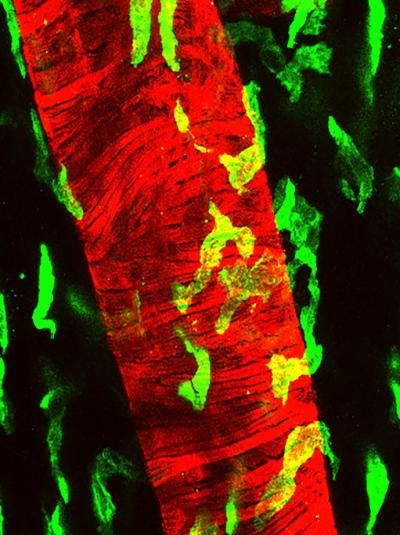Key to artery health lies in LYVE-1 macrophage

Macrophages coat the surface of blood vessel to maintain their structure and function. Green: macrophage; Red: blood vessel. Credit: Dr. Veronique Angeli
A team of researchers at NUS Medicine, led by Associate Professor Veronique Angeli, has identified a population of cells called macrophages that coat the outer walls of healthy arteries and express a protein called LYVE-1.
The researchers found that when these cells were absent, arteries accumulate collagen and lose their elasticity, becoming stiff and inflexible.
These findings suggested that the macrophages protect our arteries from becoming stiff, a concept that the team proceeded to prove.
They showed that the macrophages interact with another type of cell residing in the artery called smooth muscle cells, which produce collagen. The interaction between the two types of cell reduces the production of collagen by the smooth muscle cells.
Associate Professor Angeli and team showed that the LYVE-1 protein on the macrophages is actually responsible for this protective effect.
LYVE-1 binds to a molecule called hyaluronan expressed at the surface of smooth muscle cells and this interaction is required for the degradation of collagen by an enzyme called matrix metalloproteinase 9 (MMP-9).
The work has clinical implications for both aging and cardiovascular diseases because arterial stiffness is associated with aging and precedes cardiovascular diseases such as atherosclerosis and aneurysm.
This knowledge should help in the development of new treatments or the improvement of existing treatments for arterial diseases.
Media Contact
More Information:
http://dx.doi.org/10.1016/j.immuni.2018.06.008All latest news from the category: Health and Medicine
This subject area encompasses research and studies in the field of human medicine.
Among the wide-ranging list of topics covered here are anesthesiology, anatomy, surgery, human genetics, hygiene and environmental medicine, internal medicine, neurology, pharmacology, physiology, urology and dental medicine.
Newest articles

Sea slugs inspire highly stretchable biomedical sensor
USC Viterbi School of Engineering researcher Hangbo Zhao presents findings on highly stretchable and customizable microneedles for application in fields including neuroscience, tissue engineering, and wearable bioelectronics. The revolution in…

Twisting and binding matter waves with photons in a cavity
Precisely measuring the energy states of individual atoms has been a historical challenge for physicists due to atomic recoil. When an atom interacts with a photon, the atom “recoils” in…

Nanotubes, nanoparticles, and antibodies detect tiny amounts of fentanyl
New sensor is six orders of magnitude more sensitive than the next best thing. A research team at Pitt led by Alexander Star, a chemistry professor in the Kenneth P. Dietrich…





















